The ground support services market in the Balkan region still suffers from a lack of competition, but positive shifts are evident as the leading airports acknowledge the problem and take steps in the right direction.
As most countries in this part of Europe lean towards EU accession, slowly but steadily embracing EU standards, there are even more reasons for optimism.
Since the end of the Covid-19 pandemic, airports across the Balkan region have seen a steady surge in passenger and cargo traffic.
“The past few years have been very dynamic for airports in the former Yugoslavia,” says Luka Popovic, an independent expert and the head of EX-YU Aviation, a Belgrade-based aviation news website.
Popovic indicated that the Balkan region was the first in Europe to recover from the decline in traffic caused by the pandemic, with most airports surpassing their pre-Covid heights by late 2022.
The Balkan region, currently home to 22 airports, is seeing notable growth in passenger traffic. Belgrade Nicola Tesla Airport, the undisputed leader in this regard, saw a remarkable 29% surge in passenger flow in 2023, reaching 7.95 million.
In total, 10 Balkan airports welcomed over a million passengers in 2023, official figures indicated. For many airports, the surge in traffic figures in recent two years has become a challenge, as existing infrastructure struggled to catch up with the growth, Popovic notes.
“For example, in Belgrade, the busiest in the former Yugoslavia, the airport was unable to cope with the big increase in passenger numbers last summer, resulting in delays. As a result, the airport completely exited the provision of ground handling service, leaving the task up to private providers,” Popovic says.
In March 2024, Serbia transferred ground handling services to Menzies Aviation. The move followed sharp criticism of the airport’s French concessionaire Vinci by the Serbian Government, which expressed frustration over weeks of delays, cancellations, and overcrowding during the high summer season.
A lack of competition is believed by many to be the key reason why Balkan airports run into problems facilitating growth traffic.
“Contrary to the EU and EEA, and with the notorious exceptions of Slovenia and Croatia, which are members of the EU, the other ex-Yugoslavia entities are not bound by the obligation to have at least two ground handling service providers per airport of more than two million passengers,” says Fabio Gamba, managing director, at the European Airport Services Association.
However, Gamba indicates that he doesn’t have a full picture to confidently say how this translates into reality, aside from the Belgrade Nicola Tesla airport.
“I see at other airports – Sarajevo, for instance – that a few small entities compete for a small share of the traffic,” Gamba says.
Ahead of the curve

The Belgrade Airport contract with Menzies is likely to be a pivotal event for the Balkan region, where most airports are still reluctant to pass control over ground support services to outsiders.
Although it has only been a few months since Menzies was put in charge of the ground handling services at the airport, positive changes have already been seen, commented Ana Marojevic, general manager of Serbia and Montenegro at Menzies Aviation.
“Business has been going well, and we’ve made positive progress to streamline operations and roll out our ramp handling, baggage, de-icing and passenger services at Belgrade Nikola Tesla Airport,” Marojevic says.
Works at the airport are in the final phase, and are set to increase capacity, comfort, efficiency and deliver an improved experience for passengers and airlines. The airport’s modernization is part of Vinci Airports’ ambitious €732 million (U$814 million) extension and modernization project, enabling the airport to reach a total capacity of 15 million passengers per year by the end of the concession period.
“This modernization process is a significant step towards enhancing operations and will positively impact our own operations. For example, improved infrastructure for ground handling operations will reduce transfer times for baggage collection, further enhancing the passenger experience,” Marojevic says.
Marojevic reveals that Menzies is working in close cooperation with its partner and Serbian national carrier, Air Serbia, which currently operates more than 60% of all traffic at the airport, supporting the airline’s growth and keeping pace with its further expansion.
“Strategically, as the number one service provider in the world and the number one provider in the region, our joint venture with Air Serbia represents a major step for Menzies, supporting our ambitions to expand our presence in the Balkans and support emerging aviation markets,” Marojevic says.
Menzies also harbours plans to expand its operations in the ex-Yugoslavia region in the coming years. Marojevic stated that the company is most active in the Western Balkans, where the brand originates, with more than 25 locations across nine countries, including Serbia, Montenegro, Croatia, Bosnia and Herzegovina, Slovenia, Albania, North Macedonia and Romania.
“These regions offer immense potential and have seen a significant development in luxury travel driven by factors such as improved infrastructure, increased disposable income, and a rising interest in premium travel services,” Marojevic says.
Not the EU

The former Yugoslavia region is very similar to EU member states culturally and historically. However, as most countries of the Balkan region are not yet members of the block, the ground support services market is much different from that in other European countries.
“The Balkan region, unlike Western Europe, is not dominated by full-service FBOs. While there are some airports that do have them, it is very rare,” says Gareth Danker, director of sales at Euro Jet.
Most airports are state-owned, though market players are seeing more go under concession with various airport management companies.
Either way, the focus of these airports, especially in the summer, will be the regularly scheduled commercial flights, which are primarily carrying tourists, Danker adds.
“The main difference is that ground support services in the Balkan region are less developed compared to the majority of EU markets,” Popovic says, admitting that this factor comes with a certain cost for market players’ operation in these airports.
“There is much less competition, and in many cases, the airport itself is the ground support services provider, which is not the case in most EU nations where this sector has been outsourced.
“At the overwhelming majority of airports in the former Yugoslavia, there is just one ground service provider.
This means there is less competition and potentially a higher cost to ground handling services,” Popovic adds.
However, international companies expanding their operations in the Balkans bring the world’s best practices to the region.
“At Euro Jet, we work to support private aviation flights with our own representatives on the ground and other partner companies to ensure that the service level and experience received will be the equivalent of what one would get from a Western European FBO,” says Danker.
“We create what we like to call a Virtual FBO. Our agents on the ground will ensure all handling providers are ready for each operation and then coordinate with other vendors such as caterers and transportation companies to make sure they are on time and ready to provide the required service,” Danker says.
However, market players believe that as the region’s rapprochement with the EU continues and more countries embrace European aviation standards, the sector’s liberalization is just around the corner.
“The main trend is that the region is slowly following its EU counterparts in liberalizing this sector,” Popovic says, adding that, in general, all regional airports look into options for lowering costs and streamlining operation as the struggle for passenger and cargo traffic is fierce.
“Another visible trend is the improvement in technology and infrastructure for ground handling. In Ljubljana, the airport has acquired technology to identify bottlenecks in ground handling in order to expedite turnaround time,” Popovic adds.
In fact, the region faces a need to ramp up its standards as airports compete for passengers not only between themselves but also with the EU hubs.
“In previous years, due to the pandemic and the strict travel restrictions imposed in Western and Southern Europe, the Balkans experienced a rapid increase in flights as they had less restrictive pandemic rules,” Danker recalls.
“A large proportion of the holiday makers have since returned to France, Italy, and Spain, but the traffic in the Balkans region remains strong. This is particularly true for such countries as Croatia, Montenegro, Serbia, Bosnia and Herzegovina, North Macedonia, and Kosovo,” Danker adds.

Market players are generally optimistic about the vast region’s potential, which is reflected in the inflow of investments. “In an effort to continuously provide our customers with only the highest level of service, we have opened new crew lounges over the past few years. This includes lounges in Dubrovnik, Split, and Zagreb, Croatia; Belgrade, Serbia; Sarajevo, Bosnia and Herzegovina, Pristina, Kosovo, and Tirana, Albania. We also have our own ramp cars throughout the region,” Danker says.
Industry experts also indicated that, unlike airports in the Eastern and Central parts of Europe, the Balkans felt almost no impact from the Ukrainian conflict.
“The war in Ukraine has created a somewhat artificial boom in some markets as passengers in Ukraine have to seek alternatives, while many Russian passengers have to transfer through other airports. I don’t think this has had a major impact on the former Yugoslav markets, except for overflights which have increased as airlines have to avoid Ukrainian airspace, and most avoid Russian airspace,” Popovic says.
The general outlook for airports in the Balkans remains primarily bright, as the market attracts new investors and is growing more sophisticated.
“There has been investment into the region over the past few years,” Danker says. “While a lot of new investment goes toward the main commercial terminal, which is used for passenger flights, there have been some examples of new facilities for private aviation. In Dubrovnik, a brand-new general aviation terminal [GAT] terminal opened up a few years ago, Zagreb has renovated its GAT, and Sarajevo opened up a VIP area connected to its main terminal.”
“The Balkans is definitely becoming an attractive region, considering the rise in traffic, increase in tourism and the big potential it still holds,” Popovic agrees.





